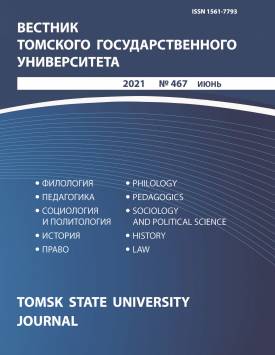A Study of University Graduates’ Migration in Regions with High Migration Outflow: A Digital Footprint Analysis
According to the hypothesis of our research, large regional universities should be centers attracting the most talented and promising youth. Official statistics provide only a general idea of migration processes. Methods for analyzing digital footprints of social network users provide additional information about graduates and applicants of universities, their socio-demographic characteristics, career trajectories, and geography of migration. The aim of this article is to give a typology of universities in donor regions based on the peculiarities of graduates’ migration through digital footprints on the social network VKontakte. The first stage was identification of regions with the highest migration outflow of the population, according to the data of the current registration. Then, using a platform for collecting and analyzing data from social networks, we downloaded the profiles of graduates of the largest university in each region. The key criteria were university affiliation, hometown, and the city of current place of residence. The database contained profiles of 267,318 people who indicated their affiliation with graduates from a particular university in the region, 28.5% indicated both their place of current residence and their hometown. For each university, we have compiled a ranking of places before and after graduate migration, and calculated the coefficients of settling down, intraregional return, and metropolitanity. Using the method of hierarchical cluster analysis, we have made a typology of universities in donor regions and identified the features of the graduates’ migration behavior. The first type is characterized by high relative values of all coefficients in comparison with other types. The second type is characterized by rather high values of the settling down coefficient and average values of intraregional return. However, the metropolitanity coefficient of universities in this group is practically zero. This is the key distinguishing feature of this type. The third type is distinguished by an average value of the settling down coefficient, a low intraregional return coefficient, and an average metropolitanity coefficient. The fourth type is characterized by an average value of the settling down coefficient, a high value of the intraregional return coefficient, and a low value of the metropolitanity coefficient. The analysis of digital footprints of university graduates in donor regions has confirmed the fact that though the idea of the need for higher education exists in the minds of Russians, residents of the Russian Federation prefer to receive it in regions with a sufficient number of jobs and a high level of education. Even large regional universities in donor regions are only centers of intraregional migration. Most graduates do not change their place of residence. The leaders of interregional migration are capital cities, million-plus cities, cities with a favorable climate, and foreign countries.
Keywords
regional migration, migration donor regions, university graduates, digital footprints, data analysis, hierarchical cluster analysis, VKontakteAuthors
| Name | Organization | |
| Mitiagina Ekaterina V. | Vyatka State University | usr07868@vyatsu.ru |
| Konyshev Evgeny V. | Vyatka State University | konj@bk.ru |
| Chernyshev Konstantin A. | Federal Research Sociological Center of the Russian Academy of Sciences | kochern@rambler.ru |
| Saifulin Eduard R. | Tomsk State University | sayfulin@data.tsu.ru |
References

A Study of University Graduates’ Migration in Regions with High Migration Outflow: A Digital Footprint Analysis | Vestnik Tomskogo gosudarstvennogo universiteta – Tomsk State University Journal. 2021. № 467. DOI: 10.17223/15617793/467/18
